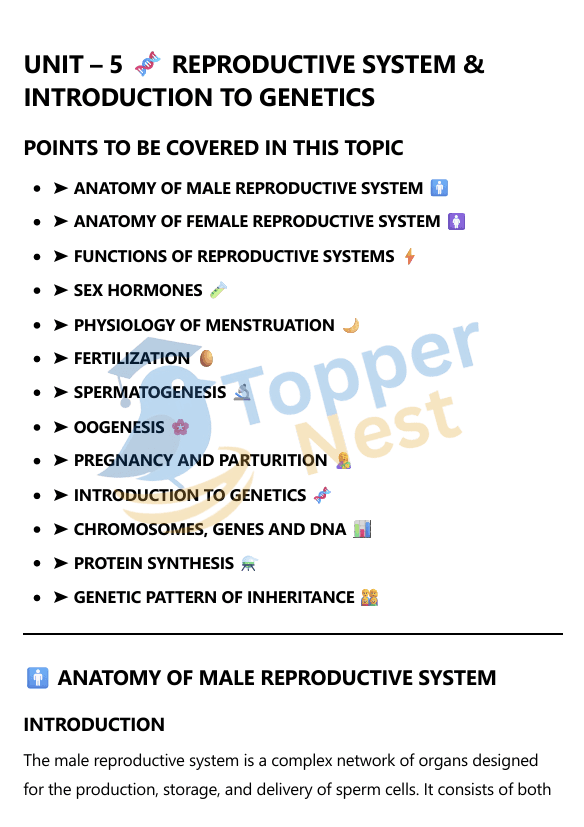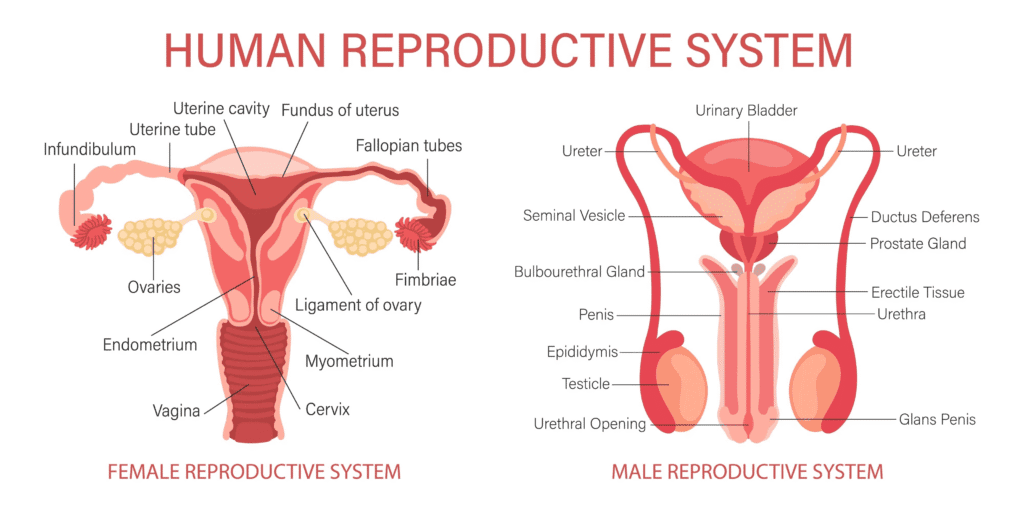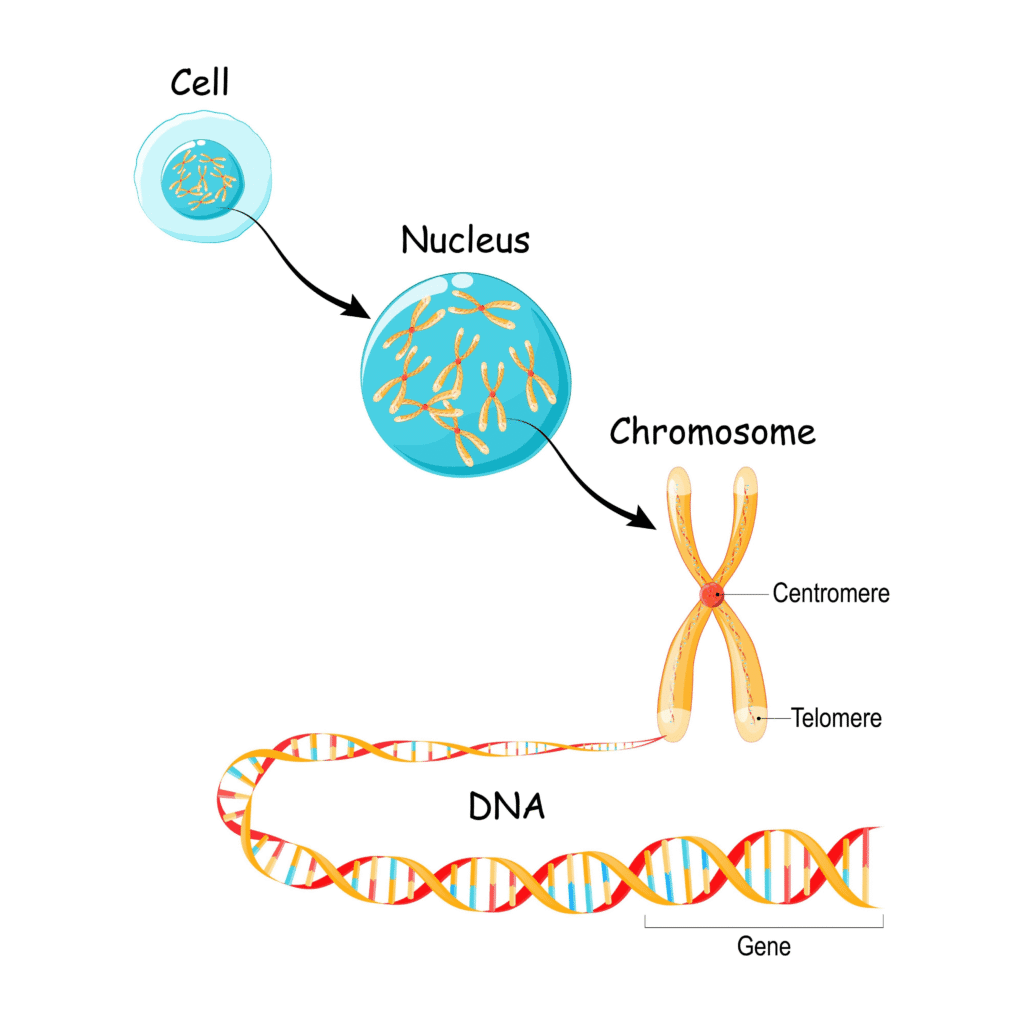The continuation of life depends on reproduction, and in higher organisms like humans, it is carried out through a highly specialized reproductive system. Both male and female reproductive systems work in harmony, regulated by sex hormones, to ensure the processes of gamete formation, fertilization, pregnancy, and childbirth. Alongside reproduction, genetics plays a central role in passing traits from parents to offspring, ensuring both variation and continuity of life.
This unit focuses on the anatomy and physiology of reproduction, the mechanisms of fertilization and development, and the basic principles of genetics that form the foundation of heredity.

Reproductive System reproductive system
Anatomy and Functions
The male reproductive system includes the testes, epididymis, vas deferens, seminal vesicles, prostate gland, and penis. The primary function is to produce and transport sperm and to produce male sex hormones. The testes produce sperm (spermatogenesis) and testosterone. The epididymis stores and matures sperm. The vas deferens transports sperm. Glands like the seminal vesicles and prostate gland produce semen, which nourishes and transports sperm.
The female reproductive system includes the ovaries, fallopian tubes, uterus, cervix, and vagina. The main functions are to produce eggs (oogenesis), facilitate fertilization, and provide a nurturing environment for a developing fetus. The ovaries produce eggs and the female sex hormones estrogen and progesterone. The fallopian tubes transport eggs and are the usual site of fertilization. The uterus is where a fertilized egg implants and develops.

Sex Hormones
Sex hormones are crucial for the development and function of the reproductive organs. Testosterone is the primary male sex hormone, responsible for the development of male secondary sexual characteristics and spermatogenesis. Estrogen and progesterone are the key female sex hormones. Estrogen promotes the development of female secondary sexual characteristics and the thickening of the uterine lining. Progesterone is essential for maintaining pregnancy and further prepares the uterus for implantation.
Physiology of Menstruation, Fertilization, and Pregnancy
The menstrual cycle is a repeating biological process in women that prepares the body every month for a possible pregnancy. Hormones coordinate changes in both the ovaries and the uterus throughout the cycle. When no fertilization occurs, the uterine lining that had built up is released as menstrual bleeding. A full cycle generally spans around 28 days, though it can vary, and is commonly described in four stages: menstruation, follicular phase, ovulation, and luteal phase.
Fertilization is the fusion of a sperm and an egg to form a zygote. This typically occurs in the fallopian tube. The zygote then travels to the uterus, where it implants in the uterine wall.
Pregnancy is the period from fertilization to birth, where a fetus develops in the mother’s uterus. It is divided into three trimesters. Parturition, or childbirth, is the process of giving birth, which involves labor and the expulsion of the baby and placenta.
Gamete Formation: Spermatogenesis and Oogenesis
Spermatogenesis is the process of sperm production in the testes. It is a continuous process that begins at puberty and results in the formation of four haploid sperm from one diploid spermatogonium.
Oogenesis is the process of egg formation in the ovaries. This process begins before birth, pauses, and then resumes at puberty. It results in the formation of one haploid egg and two or three polar bodies from one diploid oogonium.
Introduction to Genetics genetics
Genetics is the study of heredity and the variation of inherited characteristics. It explores how traits are passed from parents to offspring.
Chromosomes, Genes, and DNA
Chromosomes are thread-like structures located inside the nucleus of a cell. They are made of DNA (deoxyribonucleic acid) and protein. They carry genes, which are the fundamental units of heredity.

DNA is a double-helix molecule that contains the genetic instructions for the development and function of all known living organisms. A gene is a specific segment of DNA that codes for a specific protein.
Protein Synthesis
Protein synthesis is the process by which cells build proteins. It involves two main steps:
- Transcription: The DNA sequence of a gene is copied into a messenger RNA (mRNA) molecule.
- Translation: The mRNA molecule is “read” by a ribosome, which uses the genetic code to assemble a specific chain of amino acids, forming a protein.
Genetic Pattern of Inheritance
The genetic pattern of inheritance describes how traits are passed down through generations. These patterns were first described by Gregor Mendel. Key patterns include:
- Dominant and Recessive Inheritance: A dominant allele (version of a gene) will express its trait even if only one copy is present, while a recessive allele requires two copies to express its trait.
- Co-dominance: Both alleles in a heterozygous individual are expressed.
- Incomplete Dominance: The dominant allele does not completely mask the recessive allele, resulting in a blended phenotype.
- Sex-linked Inheritance: Genes located on the sex chromosomes (X or Y) are inherited in a specific pattern.
